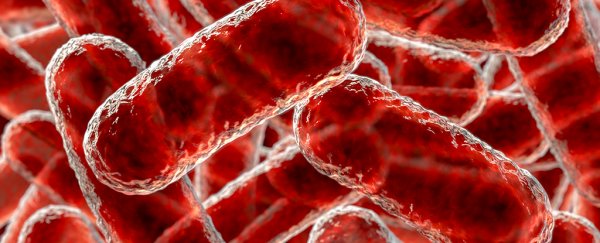As the name itself suggests, you really don't want a flesh-eating infection. The terrifying affliction can make quick work of your body's tissues, and new research confirms this type of attack is performed not just by one type of bacterium, but an entire cartel of microbes.
So-called 'polymicrobial' diseases caused by collaborating parasites, bacteria, viruses, or fungi have been on the radar of pathologists for years, but until fairly recently, necrotising fasciitis was assumed to be a one-germ-job.
That turned out to not be the case. Several years ago, a patient was discovered with an infection made up of two strains operating as one. To work out how the germs were doing it, in the new study researchers infected mice with mutant strains of the bacterium Aeromonas hydrophila, and found they were indeed teaming up.
"One of the strains produces a toxin that breaks down muscle tissue and allows the other strain to migrate into the blood system and infect the organs," says bacteriologist Rita Colwell from the University of Maryland Institute for Advanced Computer Studies.
Any one of a number of bacteria can be responsible for this horrible disease. Streptococcus pyogenes is the most common, but species of Staphylococcus, Klebsiella, and Aeromonas are often implicated.
In fact, it was a specific case of A. hydrophila infection that caught the attention of Colwell and her colleagues. The team genetically screened the microbes from necrotic tissues in an immunocompromised patient, finding the two distinct lineages at fault.
Their discovery of how the two strains get the job done builds on previous work. In earlier studies of the samples of isolated microbe, researchers found neither of the strains – simply referred to as NF1 and NF2 – could give rise to a nasty infection all on their own. But combined, their individual abilities to either seek or destroy made them a formidable duo.
The clues to their collaboration seemed to lie in the kinds of genes each strain possessed. The researchers found that NF1 had a unique type of secretion system, for example, which helped the agent gain an edge over other bacteria and survive immune attacks more readily.
While NF2 didn't have this ability to wipe out competitors, it was instead armed with a toxin called exoA that switched off important gene-reading tasks inside our own cells, effectively killing them with a shot to the heart.
To get to the bottom of it, in this latest study researchers exchanged the genes between NF1 and NF2, making each act a little more like its team-mate instead of its usual self. These mutant strains were then tested on mice to trace their pathology.
The team discovered that the original, non-mutant NF1 strains couldn't move very far once it entered a wound, lacking an ability to break down the surrounding flesh. Only once its buddy NF2 came along could it move, with the second strain liquefying tissue to clear a path.
To top things off, NF1 eventually knifed its team-mate in the back, injecting it with bacteria-murdering chemicals to ensure it could eat up all the resources by itself and stick around for longer, too.
Knowing exactly how each strain works could provide a path towards developing targeted drugs that ensure all strains are put out of action to fully treat the devastating infection.
Quick intervention through heavy-hitting doses of antibiotics and surgical removal of dead tissue is often vital if patient is to survive at all, but it only works if all traces of the infection are taken care of. Even then, survival can be as low as 66 percent, and patients are often left with severe deformities.
"We're excited by this very elegant detective work," says Colwell.
"We now have the ability through metagenomics to determine the individual infectious agents involved in polymicrobial infections. With these powerful new methods we can determine how microbes work together, whether they're bacteria, viruses or parasites."
This research was published in PNAS.
